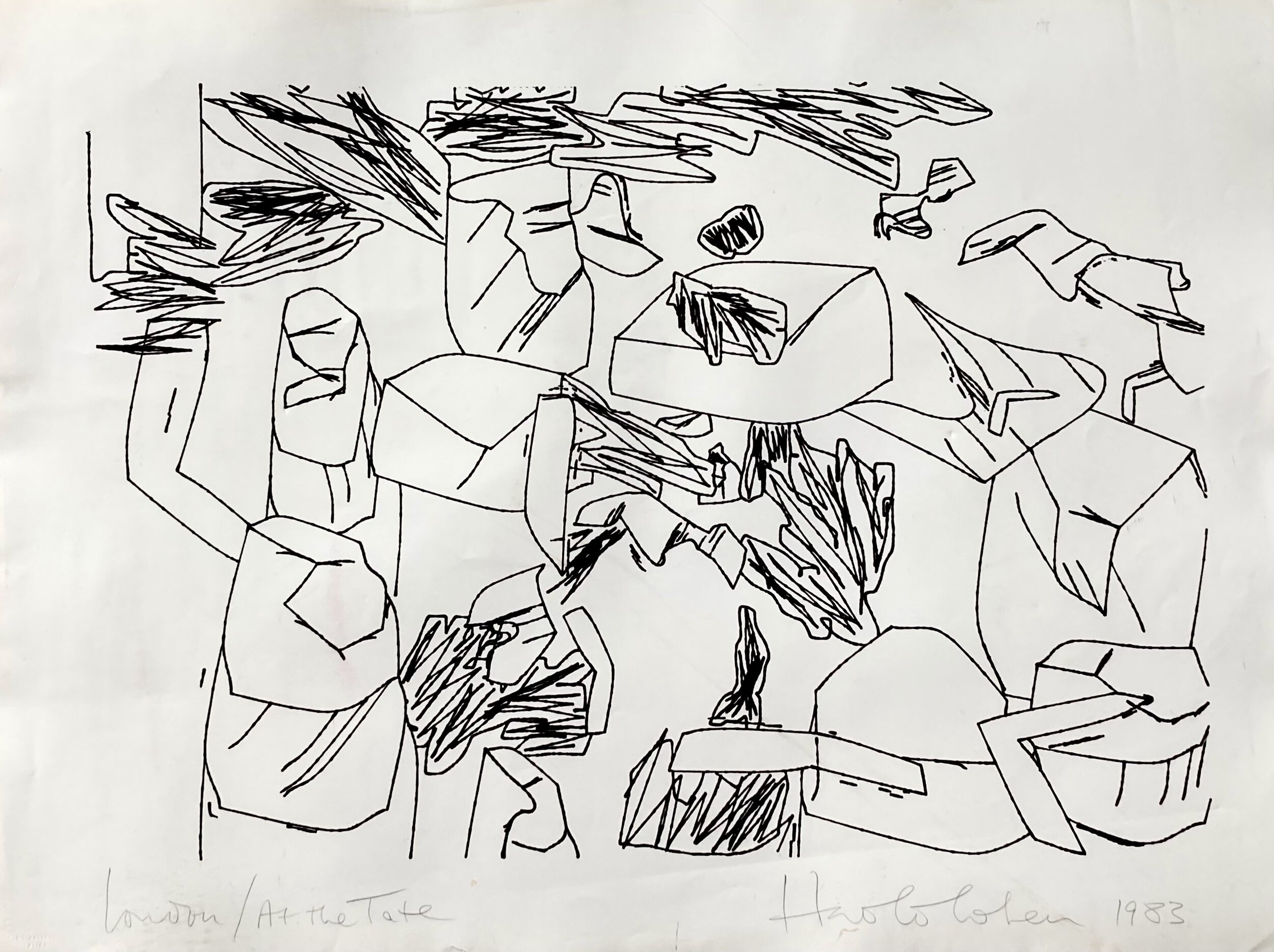 Image 1 of 8
Image 1 of 8

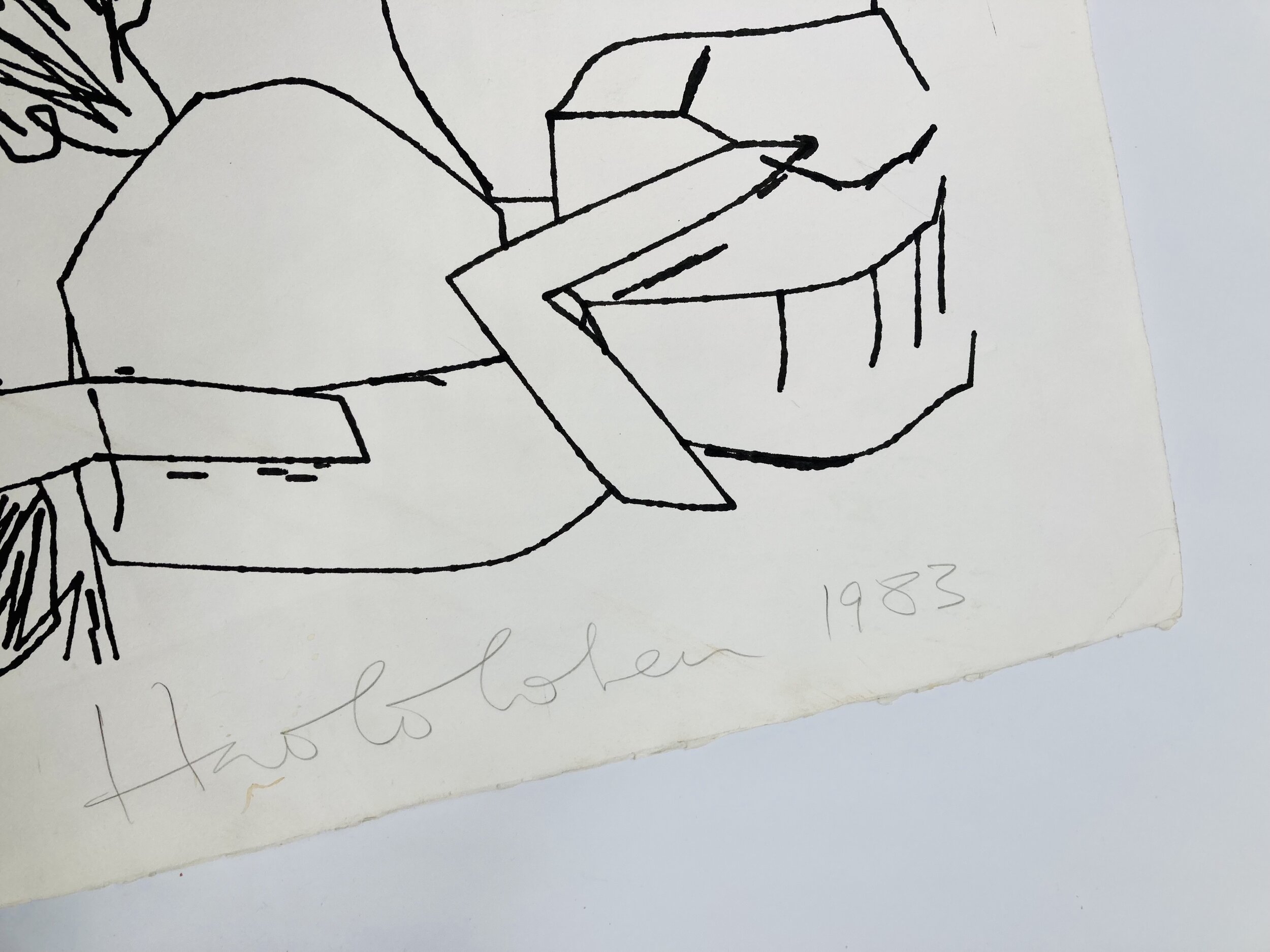 Image 2 of 8
Image 2 of 8

 Image 3 of 8
Image 3 of 8

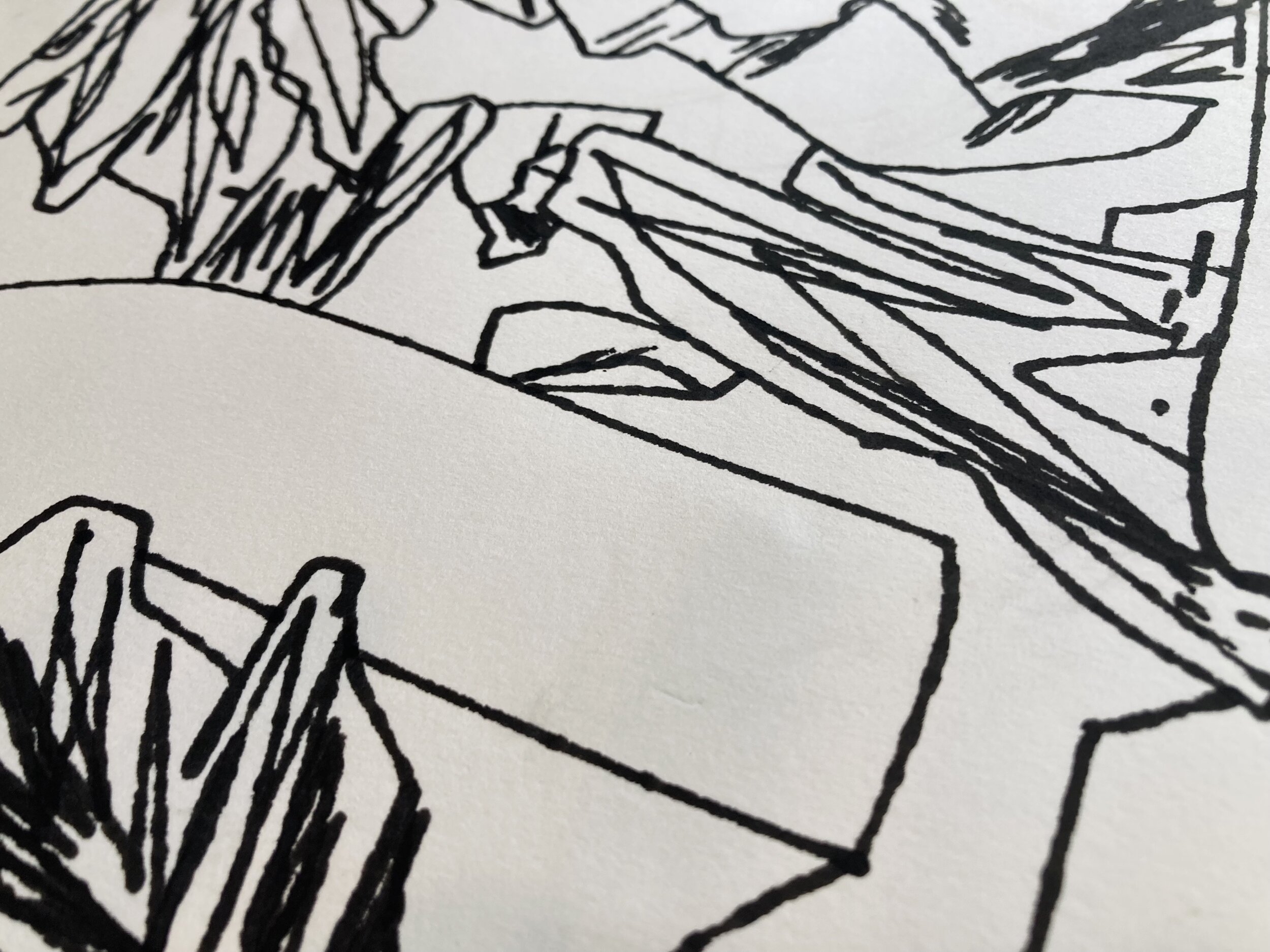 Image 4 of 8
Image 4 of 8

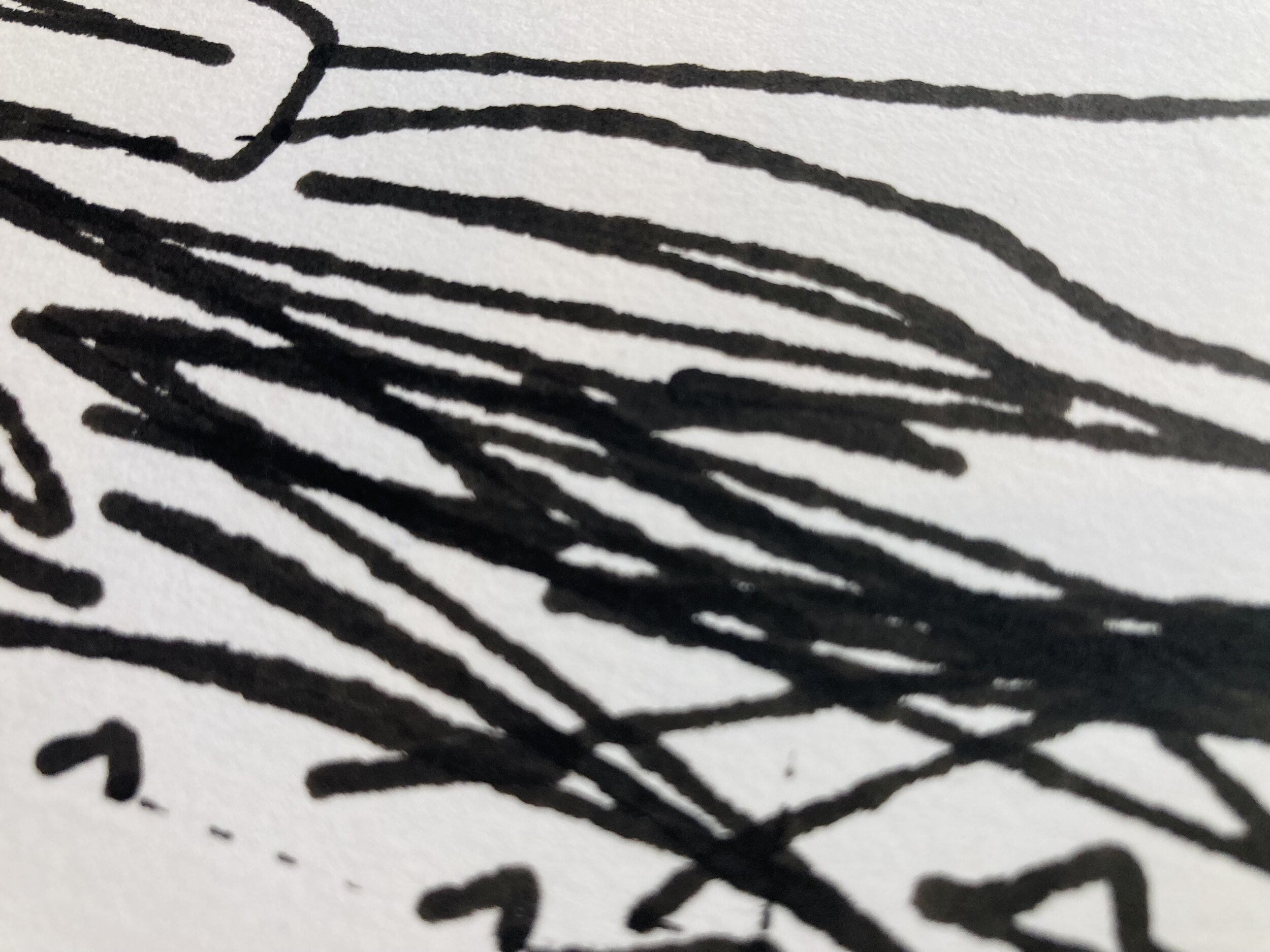 Image 5 of 8
Image 5 of 8

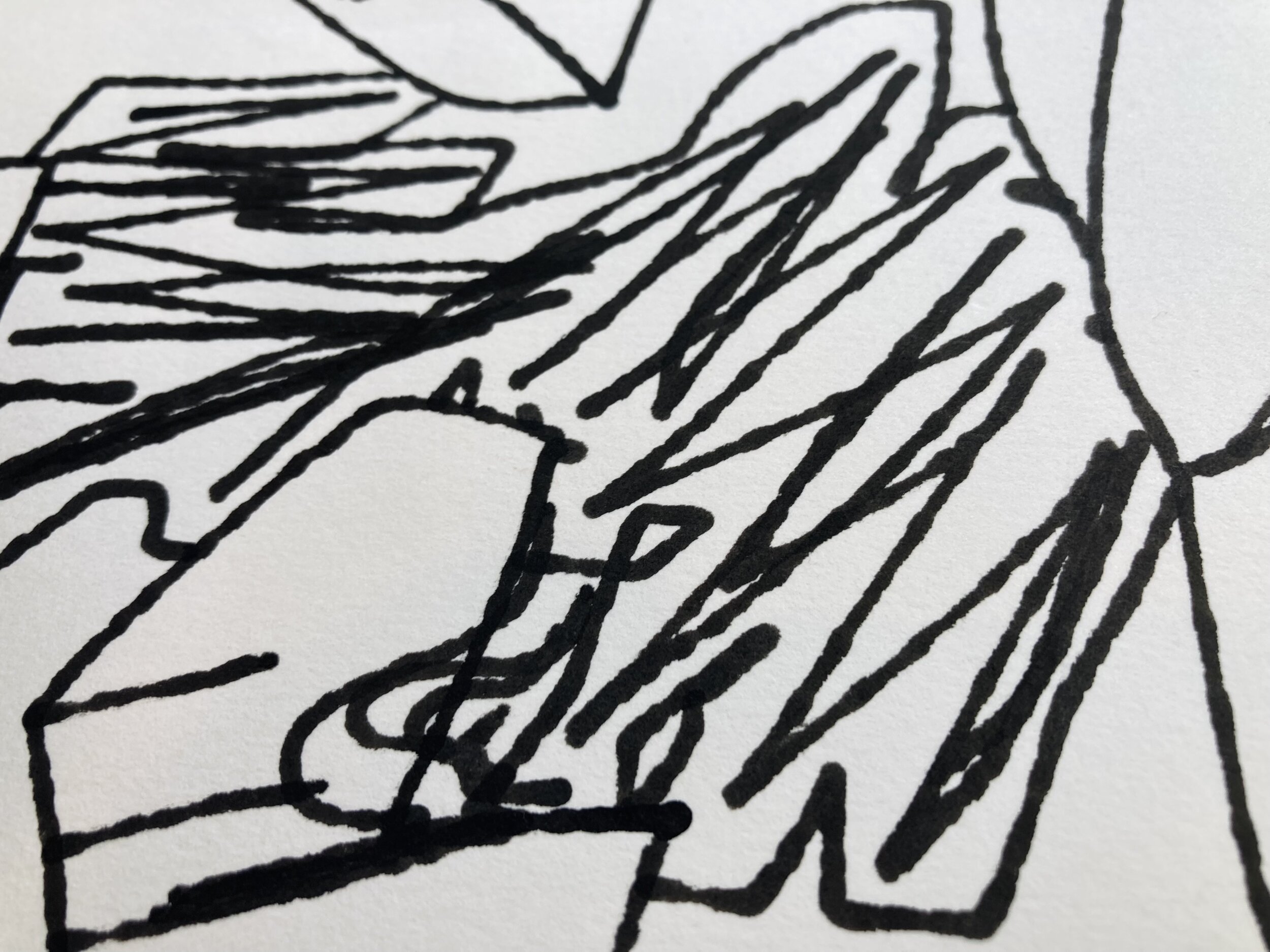 Image 6 of 8
Image 6 of 8

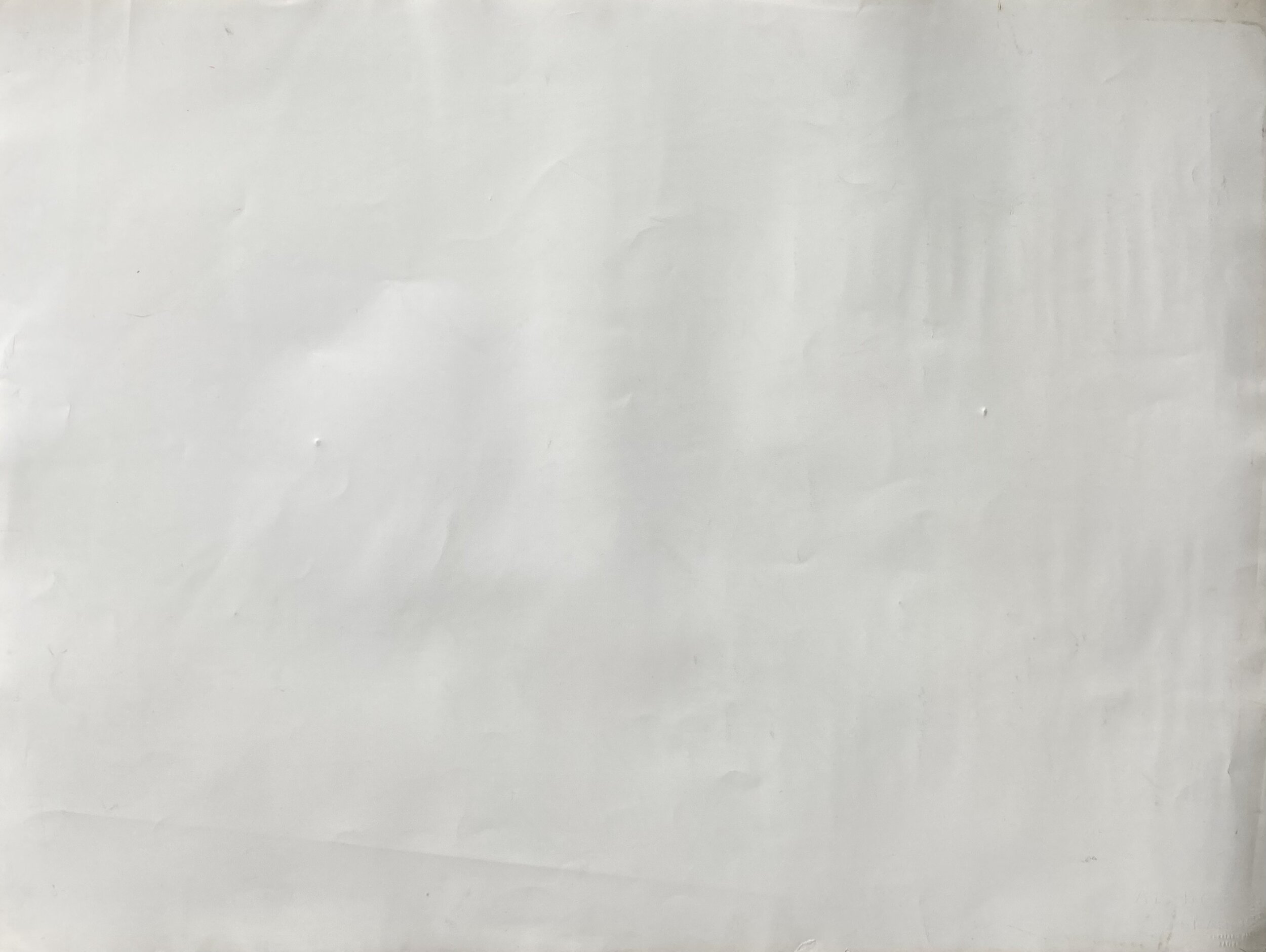 Image 7 of 8
Image 7 of 8

 Image 8 of 8
Image 8 of 8









London / At the Tate (1983) | Harold Cohen [AARON]
76 x 57 cm. Unique artwork generated by an AI system (AARON) and produced in real time by a custom robotic drawing apparatus outfitted with a black felt pen. On Arches fine paper in light cream stock with four natural deckle edges. Signed in pencil by Cohen, along with title and date. A subtle crease extends diagonally across the bottom right of the piece. Two small vertical creases appear at top right. There are other light creases and indentations on the left edge, likely the evidence of rolling the piece for shipping. The bottom right corner is slightly dog-eared. Various other marks and blemishes appear on the work. All that being said, the drawing is crisp and the paper is bright, with no foxing. Notably, this machine drawing is among the more action-packaged that we’ve encountered from this period of AARON’s work.
Harold Cohen (1928–2016) was already a successful abstract painter when he first encountered the computer as a visiting professor at the University of California, San Diego, in 1968. Smitten with the machine, Cohen took on a permanent position at UCSD, where he began working on a computer program called AARON. The artist then spent the next five decades—until his death in 2016—continuously developing the system. AARON is now among the most famous AI programs ever created, and it has instigated an entire subfield called computational creativity, where researchers investigate the phenomenon of creativity through computational means.
Like any artist, Cohen’s practice evolved over time, across a series of programming languages (and AI paradigms) and a succession of custom drawing machines, all built by the artist. AARON’s style has changed in turn, proceeding from abstract doodling to more representational forms, and finally back to abstraction (though more expressionistic than the system’s early outputs). While AARON’s initial work is strictly in black, color was introduced in the late 1980s—though Cohen hand-painted some works earlier on, a practice that inspired the legendary First Artificial Intelligence Coloring Book (1984).
For your consideration here is a unique piece from the London / At the Tate series that was produced onsite during Cohen’s exhibition at the Tate in the summer of 1983. Attendees there would have encountered four custom robotic drawing machines, each driven by AARON and articulating a crossbeam with an attached felt pen. These machines ran continuously throughout the exhibition, churning out new pieces in about twenty minutes each. Here’s a video of the machines at work. An Evening Standard reviewer remarked the following about the spectacle of AARON and its robotic apparatus drawing in real time:
Sometimes its point descends and remains on the paper for quite a while, drawing a sequence of confident lines. But then its fluent motion begins to grow jerky, making a few short, stabbing marks or vigorously thickening contours which are already there. At other times the pen hovers above the paper, moving but not drawing at all. It appears, uncannily, to possess a mind of its own.
While previously Cohen had sold hand-painted AARON drawings for four-figure amounts, these works produced onsite (and pencil-signed by Cohen) were sold to attendees for £10.50 each (about $30 today). Though an estimated 4000 examples were created during the exhibition, the series is surprisingly scarce today. The Database of Digital Art does not include any examples, and curiously the Tate itself holds nothing from the series. Artnet indicates no auctioned examples, while Invaluable lists a handful, most of which are misidentified as lithographs or (human) sketches. The Anne and Michael Spalter Digital Art Collection—the world’s most extensive collection of generative art—holds two works from London / At the Tate. We have previously handled another example.
To be clear, this is not a print! It is a unique artwork that was conceived by an AI system and physically realized by a custom robotic drawing apparatus. It is an early example by a pioneer of generative art, produced by one of the twentieth century’s most important computer programs. In an era in which tokenized digital images fetch enormous sums, this fiercely nonfungible artifact serves as a relatively affordable 1/1—one from the early period of the form, by one of its most important practitioners.
This item has been sold.
76 x 57 cm. Unique artwork generated by an AI system (AARON) and produced in real time by a custom robotic drawing apparatus outfitted with a black felt pen. On Arches fine paper in light cream stock with four natural deckle edges. Signed in pencil by Cohen, along with title and date. A subtle crease extends diagonally across the bottom right of the piece. Two small vertical creases appear at top right. There are other light creases and indentations on the left edge, likely the evidence of rolling the piece for shipping. The bottom right corner is slightly dog-eared. Various other marks and blemishes appear on the work. All that being said, the drawing is crisp and the paper is bright, with no foxing. Notably, this machine drawing is among the more action-packaged that we’ve encountered from this period of AARON’s work.
Harold Cohen (1928–2016) was already a successful abstract painter when he first encountered the computer as a visiting professor at the University of California, San Diego, in 1968. Smitten with the machine, Cohen took on a permanent position at UCSD, where he began working on a computer program called AARON. The artist then spent the next five decades—until his death in 2016—continuously developing the system. AARON is now among the most famous AI programs ever created, and it has instigated an entire subfield called computational creativity, where researchers investigate the phenomenon of creativity through computational means.
Like any artist, Cohen’s practice evolved over time, across a series of programming languages (and AI paradigms) and a succession of custom drawing machines, all built by the artist. AARON’s style has changed in turn, proceeding from abstract doodling to more representational forms, and finally back to abstraction (though more expressionistic than the system’s early outputs). While AARON’s initial work is strictly in black, color was introduced in the late 1980s—though Cohen hand-painted some works earlier on, a practice that inspired the legendary First Artificial Intelligence Coloring Book (1984).
For your consideration here is a unique piece from the London / At the Tate series that was produced onsite during Cohen’s exhibition at the Tate in the summer of 1983. Attendees there would have encountered four custom robotic drawing machines, each driven by AARON and articulating a crossbeam with an attached felt pen. These machines ran continuously throughout the exhibition, churning out new pieces in about twenty minutes each. Here’s a video of the machines at work. An Evening Standard reviewer remarked the following about the spectacle of AARON and its robotic apparatus drawing in real time:
Sometimes its point descends and remains on the paper for quite a while, drawing a sequence of confident lines. But then its fluent motion begins to grow jerky, making a few short, stabbing marks or vigorously thickening contours which are already there. At other times the pen hovers above the paper, moving but not drawing at all. It appears, uncannily, to possess a mind of its own.
While previously Cohen had sold hand-painted AARON drawings for four-figure amounts, these works produced onsite (and pencil-signed by Cohen) were sold to attendees for £10.50 each (about $30 today). Though an estimated 4000 examples were created during the exhibition, the series is surprisingly scarce today. The Database of Digital Art does not include any examples, and curiously the Tate itself holds nothing from the series. Artnet indicates no auctioned examples, while Invaluable lists a handful, most of which are misidentified as lithographs or (human) sketches. The Anne and Michael Spalter Digital Art Collection—the world’s most extensive collection of generative art—holds two works from London / At the Tate. We have previously handled another example.
To be clear, this is not a print! It is a unique artwork that was conceived by an AI system and physically realized by a custom robotic drawing apparatus. It is an early example by a pioneer of generative art, produced by one of the twentieth century’s most important computer programs. In an era in which tokenized digital images fetch enormous sums, this fiercely nonfungible artifact serves as a relatively affordable 1/1—one from the early period of the form, by one of its most important practitioners.
This item has been sold.
76 x 57 cm. Unique artwork generated by an AI system (AARON) and produced in real time by a custom robotic drawing apparatus outfitted with a black felt pen. On Arches fine paper in light cream stock with four natural deckle edges. Signed in pencil by Cohen, along with title and date. A subtle crease extends diagonally across the bottom right of the piece. Two small vertical creases appear at top right. There are other light creases and indentations on the left edge, likely the evidence of rolling the piece for shipping. The bottom right corner is slightly dog-eared. Various other marks and blemishes appear on the work. All that being said, the drawing is crisp and the paper is bright, with no foxing. Notably, this machine drawing is among the more action-packaged that we’ve encountered from this period of AARON’s work.
Harold Cohen (1928–2016) was already a successful abstract painter when he first encountered the computer as a visiting professor at the University of California, San Diego, in 1968. Smitten with the machine, Cohen took on a permanent position at UCSD, where he began working on a computer program called AARON. The artist then spent the next five decades—until his death in 2016—continuously developing the system. AARON is now among the most famous AI programs ever created, and it has instigated an entire subfield called computational creativity, where researchers investigate the phenomenon of creativity through computational means.
Like any artist, Cohen’s practice evolved over time, across a series of programming languages (and AI paradigms) and a succession of custom drawing machines, all built by the artist. AARON’s style has changed in turn, proceeding from abstract doodling to more representational forms, and finally back to abstraction (though more expressionistic than the system’s early outputs). While AARON’s initial work is strictly in black, color was introduced in the late 1980s—though Cohen hand-painted some works earlier on, a practice that inspired the legendary First Artificial Intelligence Coloring Book (1984).
For your consideration here is a unique piece from the London / At the Tate series that was produced onsite during Cohen’s exhibition at the Tate in the summer of 1983. Attendees there would have encountered four custom robotic drawing machines, each driven by AARON and articulating a crossbeam with an attached felt pen. These machines ran continuously throughout the exhibition, churning out new pieces in about twenty minutes each. Here’s a video of the machines at work. An Evening Standard reviewer remarked the following about the spectacle of AARON and its robotic apparatus drawing in real time:
Sometimes its point descends and remains on the paper for quite a while, drawing a sequence of confident lines. But then its fluent motion begins to grow jerky, making a few short, stabbing marks or vigorously thickening contours which are already there. At other times the pen hovers above the paper, moving but not drawing at all. It appears, uncannily, to possess a mind of its own.
While previously Cohen had sold hand-painted AARON drawings for four-figure amounts, these works produced onsite (and pencil-signed by Cohen) were sold to attendees for £10.50 each (about $30 today). Though an estimated 4000 examples were created during the exhibition, the series is surprisingly scarce today. The Database of Digital Art does not include any examples, and curiously the Tate itself holds nothing from the series. Artnet indicates no auctioned examples, while Invaluable lists a handful, most of which are misidentified as lithographs or (human) sketches. The Anne and Michael Spalter Digital Art Collection—the world’s most extensive collection of generative art—holds two works from London / At the Tate. We have previously handled another example.
To be clear, this is not a print! It is a unique artwork that was conceived by an AI system and physically realized by a custom robotic drawing apparatus. It is an early example by a pioneer of generative art, produced by one of the twentieth century’s most important computer programs. In an era in which tokenized digital images fetch enormous sums, this fiercely nonfungible artifact serves as a relatively affordable 1/1—one from the early period of the form, by one of its most important practitioners.
This item has been sold.